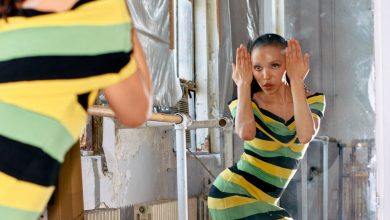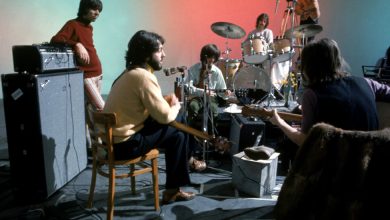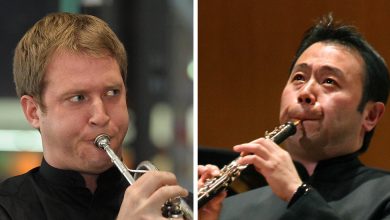How John Powers Filled a Gap in His Hand With Big Ideas and Art

BEACON, N.Y. — It was a hot day on Oscawana Lake. John Powers hosed down the dog, then started on some woodworking chores outside his lakeside cottage home in the Hudson Valley.
When Powers is stationed at a table saw, he’s usually making artwork. For his practice, he crafts small blocks that he assembles into otherworldly geometric sculptures. The futuristic objects he shows at galleries can comprise hundreds or thousands of pieces, like digital drawings rendered in real life. But on May 19, Powers was cutting decorative caps for the fence: a handyman task to please his wife, maybe impress the neighbor.
He was four or so cuts in. Then something went wrong. The block kicked back and struck him in the face. The motion dragged his left hand through the saw’s thirsty blade. One bad cut at a tool he’d relied on for 30 years.
In a flash Powers lost his ring finger and thumb. His index and middle fingers were nearly destroyed. A grueling delay awaited, as the first ambulance to carry him from the scene stalled out on a hill near his Putnam County home.
When he finally arrived at the operating room, he pleaded to hospital attendants. “I’m an artist. This is part of me, this is integral. Like, hey man, I’m not a flake, I work in a way that’s closer to what you do.”
For Powers — who trained in creating realistic bronze statues before he turned to abstract forms — the injury threatened his career. The injury also revealed a paradox. Over decades, he has refined a process to hide his considerable craft, the artist’s touch, so to speak, in order to produce seemingly factory-made objects that remain inimitably his own. But every single component is the product of precision and control.
In the weeks after the accident, Powers endured surgeries, including one to restore the severed thumb, then another to remove it again, after the digit mummified and died.
In the months since the accident, the artist gradually returned to his practice. The first piece that he built was a most-miniature coffin for his recovered thumb, which he buried in his yard in a ceremony attended by friends. “Under My Thumb” played. A gallows humor has guided Powers’s recovery. A tiny grave marks the spot.
His next project is more elusive. Through physical therapy, he is remapping the territory between his mind and his hand. He has grappled with ghostly sensations, similar to phantom limb pain, mysteries in texture and perception. He has fought to keep doubt at bay.
This project also involves enlisting other sculptors to design custom prosthetics. These will take the form of wearable attachments that will fit over his “th” and “fi” — how he describes the residual lower digits remaining on his hand. These may be purely aesthetic, even ornamental or bizarre. For people living with disability, the possibilities unlocked by digital fabrication are wide open. For Powers, it’s a problem to solve through art.
This project, the artist says — referring broadly to recovery and reorienting, in his practice and his body — is the most important work he has done yet.
Powers was born on Chicago’s South Side. His mother studied at the Art Institute and worked as an interior designer. His father, who died in 2019, was an ordained Episcopal priest who marched with Martin Luther King Jr. in Selma, and later found his calling as a clinical psychologist. Powers grew up in South Commons, an integrated development he calls “utopian.”
After his parents split up, he attended elementary school in suburban Oak Park, across the street from the home and studio of Frank Lloyd Wright. “I was seriously indoctrinated with architecture as a grade schooler,” Powers says.
He had trouble learning how to read. Art was always his outlet. By his senior year, he says, he spent most of his time in a ceramics class. One of Powers’s teachers — he flunked her class — told him about a colleague who worked at a bronze foundry in the Pacific Northwest. Powers was entranced by the idea of apprenticing under a master. He kept after the teacher: Doesn’t the foundry need an apprentice?
Riverdog Fine Arts had an opening. So Powers borrowed $50 from his dad and hitchhiked from Chicago to the foundry in Chimacum, Wash.
The job didn’t pan out but Tom Jay, a sculptor and back-to-the-land environmentalist who built the foundry, took on Powers as an assistant to help finish a monumental project, “Salmon Woman and Raven,” a Native myth in bronze. For the commission, Jay had to create a 12-foot-tall ring, a 16-foot-long canoe, two full-size human figures, and scores of salmon — an enormous assortment of statues cast in bronze. Today it holds pride of place in Highland Park in Bellevue.
Powers lived on Jay’s land, without running water, in a shack that he built out for himself. Early on, Jay asked his apprentice to go make shelves in the woods, giving him tools but no instructions. Powers still carries Jay’s lesson from that day: “If it’s beautiful, it will work better.”
Powers learned to sculpt, mold and cast. He worked with Northwest School modernists such as Hilde Morris and Native carvers alike. And he learned how artists lived.
After six years at the foundry, Powers emerged as a master craftsman. Then he hitchhiked to Brooklyn to enroll as an undergraduate at Pratt Institute (and later at Hunter College). But Powers recoiled at intro classes. He had already built a house. He didn’t feel like showing off with fancy woodwork, either.
Instead he turned to the simple Froebel blocks that had inspired Frank Lloyd Wright. Powers made dozens of rectangular blocks in similar dimensions, adopting this sacred Chicago geometry as his own. “It looked like I was doing nothing,” he says.
In 1995, Powers saw an exhibition at the Whitney Museum of American Art that changed his trajectory. It was a show about Beat Generation artists that served as a New York debut for “The Rose,” a painting by the artist Jay DeFeo that the museum had unearthed. Weighing more than a ton, the painting was as dense as a sculptural relief, the product of 12 years of obsessive labor.
Something clicked for Powers. Still at Pratt, he took over a cluttered storeroom, brought in plywood and cut his first several thousand blocks. And he started stacking them.
“His work is a marathon rather than a sprint,” says Magdalena Sawon, the co-founder of Postmasters Gallery, which hosted a solo show by Powers in 2014. For that exhibition, Powers worked every morning from dawn to the gallery’s opening, sorting piles of blocks — made of paper, plywood, polystyrene, resin and steel — into collages, installations and towers.
Powers has gone on to make monumental commissions himself, namely “Lanchals,” a 50-foot spine-shaped tower of interlocking steel parts overlooking a canal in Bruges, Belgium, for a festival in 2018. He’s done baroque things with wood, too, including several meticulously drilled-and-doweled multifaceted prisms that clutter his studio.
After the accident, the artist Mark Wagner reached out to Powers with a gift. Using a 19th-century guillotine-style paper cutter, Wagner cut thousands of pieces of paper in 10 different sizes, all rectangles in the same proportions that Powers favors. The smallest pieces are mere shavings, 1/16 by 3/16 of an inch.
Now Powers is stacking these paper pieces in layers, making works that almost resemble drawings. His years at the foundry taught him that less is more.
“Bronze has this value,” Powers says. “People pick up a bronze. The nice thing about blocks, it’s the opposite of that. Everybody knows how to stack a block.”
On the day of the accident, Powers’s wife, the designer Jennifer Bostic, was sitting on the fenced-in porch that looks out over Oscawana Lake. Had she not been sitting outside, she says, she might not have heard her husband’s scream. “I heard a sound I’d never heard before,” Bostic says.
Their next-door neighbor arrived on the scene first. Powers says he barked at the man: Help me find my fingers. They gathered them in the ball cap that Powers had been wearing.
“This is not a guy I knew very well,” Powers says. “He poured sorrow out for me.”
Bostic, who dialed 911, says she told the operator that her husband was an artist. The operator told her not to put the severed fingers on ice, she says. That advice flew in the face of what she and her husband knew to do, but they complied. Within minutes, a volunteer Putnam County E.M.T. arrived in an S.U.V. He was followed by an ambulance with two more paramedics, who loaded up Powers. Emergency medical workers on the scene told the couple that they did in fact need to keep the fingers cooled.
Then the crisis took another turn. The ambulance, an older electric vehicle, couldn’t make it up the hill on Nampaugh Road outside their home. It took 45 minutes for a second ambulance to arrive and retrieve Powers.
Other setbacks followed. The staff at Westchester Medical Center felt bullish they could save Powers’s ring finger. But after a seven-hour surgery, doctors could only reattach his thumb. Over six days in the hospital he experienced profound phantom limb sensations. One night, he says, he felt his prone hand holding strange objects, including a cow’s horn made from terry cloth and a thick, toothy plastic. His mind had assembled the textures from materials in his hospital room.
Another grim surgery loomed. The plan was to remove the mummified thumb and then surgically attach his hand to the side of his body in an effort to regrow as much of its lost vascular infrastructure as necessary. Plugging his hand into his body cavity didn’t turn out to be necessary after all. At some point during the procedure, one of the anesthesiologists decided to buy a sculpture by Powers.
“I managed to sell a piece entirely unconscious,” the artist says.
Going Beyond Functional Solutions
Adam Poots, the founder and owner of a tabletop board-game company based in Queens, N.Y., is an expert in the realm of digital fabrication. His company produces Kingdom Death, a boutique fantasy-horror game with cards, dice and monstrous hard-plastic figurines.
Kingdom Death spawns new creatures by either sculpting and printing them digitally or manufacturing them through molds. One under construction is a sadistic crocodile that feeds on cortisol, the stress hormone.
Powers asked Poots to design prosthetics for him. Not just a thumb and finger, but specifically a Kingdom Death-edition thumb and finger.
“He was introduced to me casually,” Poots says. “I didn’t realize he is on a bit of an artistic journey.”
Another sculptor, Bill Albertini, is also designing prosthetics for Powers. He’ll likely try an aluminum material. The eventual design may resemble something from Albertini’s “Pipe Dream Systems,” a sculpture series that resembles surrealist plumbing.
“I’m coming from this not as someone who’s going to make a functional prosthetic,” Albertini says. “That’s out of my wheelhouse.”
Powers is also looking to engineers to replace the everyday function of his left hand. On Jan. 5 he got fitted for custom components manufactured by Naked Prosthetics, a company that specializes in 3D-printed fingers for partial hand amputees. Powers’s insurance balked at paying for these prosthetics, but after three appeals, he persevered.
Powers is asking artists for ideas that transcend function — even if these are ornamental parts he wears to art openings. Poots’s design, for example, draws inspiration from a gauntlet prosthetic worn by a 16th-century German knight known as Götz of the Iron Hand. Powers has started a site, Open Paw, to invite artists to submit designs. Postmasters Gallery may eventually exhibit them.
He wouldn’t be alone in finding a creative outlet in his adaptation. Aimee Mullins, the Paralympic athlete and model, who had both of her legs amputated at the knee, has raced competitively in performance prosthetics. She has also sported couture prosthetics for the runway.
Today’s horizon for prosthetics involves neural-computer interfaces and other engineering marvels. But people who experience amputations and other later-in-life disabilities often turn to low-tech innovations, according to Sara Hendren, the author of “What Can a Body Do?: How We Meet the Built World.”
“Sometimes prosthetics come in the form of myoelectrics and biomechatronics,” she says, referring to top-tier lab advances. “Sometimes they come in the form of kitchen tools, straws, peel-and-stick hooks. John is entering that whole heritage.”
Powers says that he has always had a strong sense for his body’s limits. When his life feels balanced, Powers says that he can stand for hours, working in silence, making thousands of repetitive motions.
Now he doesn’t know those same limits. He feels like his training has prepared him for relearning them.
“It’s not that everything’s going to be OK,” Powers says. “It’s just that as an artist, you cannot think past what you’re doing right now. Without thinking, ‘Will I ever have another show? Will I have a retrospective? Will anyone care about this art?’”
His physical therapy was over at the end of the year. Powers says that he doesn’t know when he’ll be able to lift plywood or return to the table saw. His meticulous cuts may be out. But he can always stack blocks.
Powers says that he thinks with his hands. For now, he’s squarely focused on his recovery.
“Art has given me a way to look at this,” he says, “and take part in this.”



